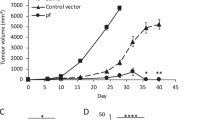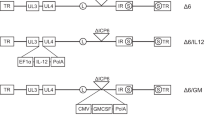Abstract
To assess the potential of immune stimulation in combination with apoptosis induction by Semliki Forest virus (SFV) and its derived vector for tumour treatment, we have utilized the poorly immunogenic and rapidly growing K-BALB and CT26 murine tumour models. Both cell lines underwent apoptosis and expressed viral antigen when infected with the SFV4 strain of SFV, or recombinant SFV (rSFV) virus-like particles (VLPs) encoding the p62-6k viral structural proteins. VLPs were used to immunize groups of BALB/c and BALB/c nu/nu mice prior to subcutaneous tumour induction and treatment. Direct intratumoral injection of VLPs or SFV4 resulted in an immediate and intense inflammatory reaction in immunized groups that was not observed in naïve groups until day 5 of treatment, and was not observed in nu/nu groups. A significantly higher level of tumour growth inhibition was observed in immunocompetent groups than in athymic mice. For K-BALB tumours, SFV4 treated groups showed greater inhibition than that observed in VLP-treated groups, with immunization prior to treatment enhancing the overall antitumour effect and immune response. No significant difference was observed in CT26 tumours between VLP and SFV4-treated groups, but prior immunization considerably enhanced the antitumoural response. It is concluded that use of the inherent apoptosis-inducing capability of SFV or its vector, by perfusion in combination with immune stimulation, may have potential for the treatment of rapidly growing tumours.
This is a preview of subscription content, access via your institution
Access options
Subscribe to this journal
Receive 12 print issues and online access
$259.00 per year
only $21.58 per issue
Buy this article
- Purchase on Springer Link
- Instant access to full article PDF
Prices may be subject to local taxes which are calculated during checkout







Similar content being viewed by others
References
Strauss JH, Strauss EG . The alphaviruses: gene expression, replication, and evolution. Microbiol Rev 1994; 58: 491–562.
Snijders A et al. Immunogenicity and vaccine efficacy of synthetic peptides containing Semliki Forest virus B and T cell epitopes. J Gen Virol 1992; 73: 2267–2272.
Atkins GJ, Sheahan BJ, Liljeström P . The molecular pathogenesis of Semliki Forest virus: a model virus made useful? J Gen Virol 1999; 80: 2287–2297.
Lundstrom K . Semliki Forest virus vectors for gene therapy. Expert Opin Biol Ther 2003; 3: 771–777.
Smerdou C, Liljestrom P . Two-helper RNA system for production of recombinant Semliki Forest virus particles. J Virol 1999; 73: 1092–1098.
Barth BU, Garoff H . The nucleocapsid-binding spike subunit E2 of Semliki Forest virus requires complex formation with the E1 subunit for activity. J Virol 1997; 71: 7857–7865.
Lundström K . Alphavirus vectors as tools in cancer gene therapy. Technol Cancer Res Treat 2002; 1: 83–88.
Morris-Downes MM et al. Semliki Forest virus-based vaccines: persistence, distribution and pathological analysis in two animal systems. Vaccine 2001; 19: 1978–1988.
Fleeton MN et al. Recombinant Semliki Forest virus particles expressing louping ill virus antigens induce a better protective response than plasmid-based DNA vaccines or an inactivated whole particle vaccine. J Gen Virol 2000; 81: 749–758.
Jerusalmi A et al. Effect of intranasal administration of Semliki Forest virus recombinant particles expressing reporter and cytokine genes on the progression of experimental autoimmune encephalomyelitis. Mol Ther 2003; 8: 886–894.
Glasgow GM et al. Death mechanisms in cultured cells infected by Semliki Forest virus. J Gen Virol 1997; 78: 1559–1563.
Glasgow GM et al. The Semliki Forest virus vector induces p53-independent apoptosis. J Gen Virol 1998; 79: 2405–2410.
Murphy AM et al. Inhibition of human lung carcinoma cell growth by apoptosis induction using Semliki Forest virus recombinant particles. Gene Therapy 2000; 7: 1477–1482.
Murphy AM, Sheahan BJ, Atkins GJ . Induction of apoptosis in BCL-2-expressing rat prostate cancer cells using the Semliki Forest virus vector. Int J Cancer 2001; 94: 572–578.
Colmenero P et al. Immunotherapy with recombinant SFV replicons expressing the P815A tumor antigen or IL-12 induces tumor regression. Int J Cancer 2002; 98: 554–560.
Withoff S et al. Replication-defective recombinant Semliki Forest virus encoding GM-CSF as a vector system for rapid and facile generation of autologous human tumor cell vaccines. Gene Therapy 2001; 8: 1515–1523.
Asselin-Paturel C et al. Transfer of the murine interleukin-12 gene in vivo by a Semliki Forest virus vector induces B16 tumor regression through inhibition of tumor blood vessel formation monitored by Doppler ultrasonography. Gene Therapy 1999; 6: 606–615.
Daemen T et al. Eradication of established HPV16-transformed tumours after immunisation with recombinant Semliki Forest virus expressing a fusion protein of E6 and E7. Vaccine 2003; 21: 1082–1088.
Ren H et al. Immunogene therapy of recurrent glioblastoma multiforme with a liposomally encapsulated replication-incompetent Semliki forest virus vector carrying the human interleukin-12 gene—a phase I/II clinical protocol. J Neurooncol 2003; 64: 147–154.
Ring CJ . Cytolytic viruses as potential anti-cancer agents. J Gen Virol 2002; 83: 491–502.
Chiocca EA . Oncolytic viruses. Nat Rev Cancer 2002; 2: 938–950.
Toda M et al. Herpes simplex virus as an in situ cancer vaccine for the induction of specific anti-tumor immunity. Hum Gene Ther 1999; 10: 385–393.
Bos JL . Ras oncogenes in human cancer: a review. Cancer Res 1989; 49: 4682–4689.
Guerrero S et al. Codon 12 and codon 13 mutations at the K-ras gene induce different soft tissue sarcoma types in nude mice. FASEB J 2002; 16: 1642–1644.
Adjei AA . Blocking oncogenic Ras signaling for cancer therapy. J Natl Cancer Inst 2001; 93: 1062–1074.
Aaronson SA, Weaver CA . Characterization of murine sarcoma virus (Kirsten) transformation of mouse and human cells. J Gen Virol 1971; 13: 245–252.
Stephenson JR, Aaronson SA . Antigenic properties of murine sarcoma virus-transformed BALB-3T3 nonproducer cells. J Exp Med 1972; 135: 503–515.
Brattain MG et al. Establishment of mouse colonic carcinoma cell lines with different metastatic properties. Cancer Res 1980; 40: 2142–2146.
Wang M et al. Active immunotherapy of cancer with nonreplicating recombinant fowlpox virus encoding a model tumour-associated antigen. J Immunol 1995; 154: 4685–4692.
Grandgirard D et al. Alphaviruses induce apoptosis in Bcl-2-overexpressing cells: evidence for a caspase-mediated, proteolytic inactivation of Bcl-2. EMBO J 1998; 17: 1268–1278.
Scallan MF, Allsopp TE, Fazakerley JK . Bcl-2 acts early to restrict Semliki Forest virus replication and delays virus-induced programmed cell death. J Virol 1997; 71: 1583–1590.
Dranoff G . Cytokines in cancer pathogenesis and cancer therapy. Nat Rev Cancer 2004; 4: 11–22.
Finn OJ . Cancer vaccines: between the idea and the reality. Nature Rev Immunol 2003; 3: 630–641.
Kuroki M et al. Immunotherapy and gene therapy of cancer using antibodies or their genes against tumor-associated antigens. Anticancer Res 2003; 23: 4377–4381.
Toda M . Immuno-viral therapy as a new approach for the treatment of brain tumors. Drug News Perspect 2003; 16: 223–229.
Yamanaka R et al. Induction of therapeutic antitumor antiangiogenesis by intratumoral injection of genetically engineered endostatin-producing Semliki Forest virus. Cancer Gene Ther 2001; 8: 796–802.
Leitner WW et al. Enhancement of tumor-specific immune response with plasmid DNA replicon vectors. Cancer Res 2000; 60: 51–55.
Tseng JC et al. In vivo antitumor activity of Sindbis viral vectors. J Natl Cancer Inst 2002; 94: 1790–1802.
Tseng JC et al. Systemic tumor targeting and killing by Sindbis viral vectors. Nat Biotechnol 2004; 22: 70–77.
Acknowledgements
We thank Marie Moore and Alex Whelan for assistance with histopathological studies, and Dorothy Mooney for assistance with laboratory protocols. This work was supported by the Enterprise Ireland Advanced Technology Research Programme, Cancer Research Ireland and the European Union 5th Framework Programme.
Author information
Authors and Affiliations
Rights and permissions
About this article
Cite this article
Smyth, J., Fleeton, M., Sheahan, B. et al. Treatment of rapidly growing K-BALB and CT26 mouse tumours using Semliki Forest virus and its derived vector. Gene Ther 12, 147–159 (2005). https://doi.org/10.1038/sj.gt.3302390
Received:
Accepted:
Published:
Issue Date:
DOI: https://doi.org/10.1038/sj.gt.3302390
Keywords
This article is cited by
-
A Semliki Forest virus vector engineered to express IFNα induces efficient elimination of established tumors
Gene Therapy (2012)
-
Inhibition of angiogenesis by a Semliki Forest virus vector expressing VEGFR-2 reduces tumour growth and metastasis in mice
Gene Therapy (2007)
-
Reciprocal effects of Th1 and Treg cell inducing pathogen-associated immunomodulatory molecules on anti-tumor immunity
Cancer Immunology, Immunotherapy (2007)
-
Regression of mouse tumours and inhibition of metastases following administration of a Semliki Forest virus vector with enhanced expression of IL-12
Gene Therapy (2005)



